Media | Articles
The V-12 and V-16 Progeny of Chevy’s Small-Block V-8
In the last seven decades, General Motors has bestowed 113 million small-block V-8 engines upon us—nearly one per American household. Given this engine’s phenomenal success, it’s no surprise that its fundamental architecture and pushrod-actuated, two-valve technology have been stretched and transformed into ambitious projects far exceeding original displacements and cylinder count. A few of these engines have been featured in high-profile builds or found their way into boats or airplanes, but all of them displayed serious ingenuity.
V-12s Then and Now
After running Andy Granatelli’s Indy racing engine program and then collaborating with Carroll Shelby for several years, Ryan Falconer opened his own shop in Culver City, California, in 1966. That year, the Ford Racing V-8 he built powered Graham Hill to an Indy 500 victory. In 2011, Falconer relocated to Chino Valley, Arizona, where this 83-year-old motor maestro is still at it.
Falconer unveiled his V-12, based on the first-generation Chevy small-block V-8, back in 1990. A Corvette powered by this engine topped 200 mph, and another Falconer V-12 propelled the Thunder Mustang, a ¾-scale P-51 aircraft. Prices started at $85,000.

Falconer retained Chevy’s 4.40-inch bore spacing, single camshaft, and pushrod-operated two valves per cylinder. His block and heads were cast aluminum, limiting weight to 520 pounds. This V-12’s crankshaft was machined from a chunk of billet steel and secured in place by a girdle incorporating all seven main bearing caps. A few of Falconer’s engines were supercharged or turbocharged, and dry-sump lubrication was also available. Displacements ranged from 8.6 to 9.8 liters, with naturally aspirated power outputs up to 640 hp at 4500 rpm. One supercharged 8.2-liter V-12 produced nearly 1000 hp in a marine application.


In addition to their power potential, every V-12 has perfect primary and secondary harmonic balance. The only flaw in V-12s descending from 90-degree V-8s is their unequal firing intervals. Instead of a power pulse every 60 degrees of crank rotation, the cylinders light off every 30 or 90 degrees. The Dodge Viper’s V-10 also suffered from this fault, though it never stunted that rabblerouser’s personality. Of course, GM understood the virtues of a 60-degree bank angle, which is why that arrangement was used in V-12–powered GMC trucks in the 1960s.
Marketplace
Buy and sell classics with confidence
Over 35 years, Falconer built and sold 55 of his V-12s for auto, marine, and aircraft applications. Currently, he’s focused on selling the Falconer L6, a 5.0-liter DOHC 24-valve inline-six originally built by GM for motorsports.
The V-12 from Down Under
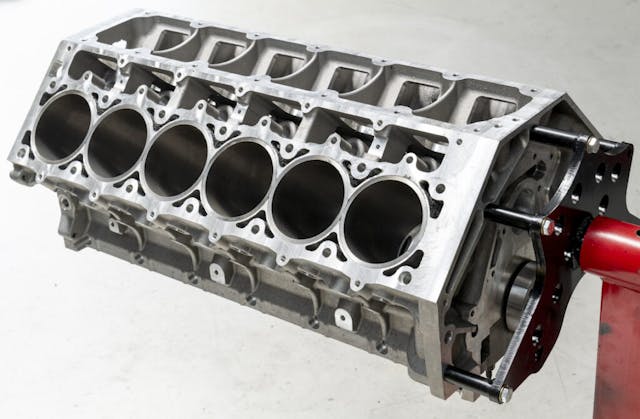
Proving that excellence can have global reach, two Australian entrepreneurs have taken up where Falconer left off. In 2018, Matt and Shane Corish’s Race Cast Engineering in Melbourne began offering V-12s based on GM’s fourth-generation small-block LS V-8. This March, one of their engines sparkled at Detroit’s Autorama under the hood of the TwelveAir sports coupe built by Kindig-It Design of Salt Lake City, Utah. Owners Dave and Tracey Maxwell, of Saltsburg, Pennsylvania, carted home the $10,000 Ridler award won by their TwelveAir creation.
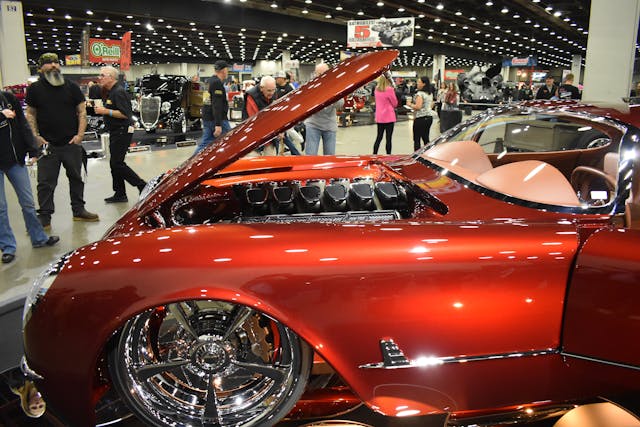
Shane Corish notes, “GM’s superb small-block V-8 provided the perfect starting point for our V-12.” Race Cast uses modern 3D printing technology to cast its blocks in aluminum or iron. (The latter is preferable for boosted applications.) While standard GM 4.40-inch bore spacing is maintained, extra head bolts have been added for improved durability, and the sides of the cast aluminum oil pan are a full inch thick to increase this V-12’s longitudinal stiffness. A Haltech Nexus electronic control unit runs the ignition and fuel injection, while induction air flow is regulated by a standard GM throttle body.
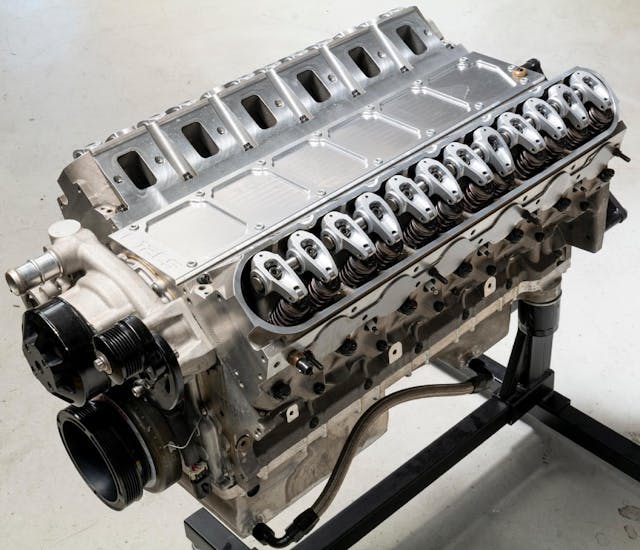
The Aussie V-12s are available as a $49,300 engine builder’s kit, with the block, heads, crankshaft, camshaft, and gaskets included. A smaller-bore aluminum block can be had for an additional $5000. Power outputs range from 750 hp in the base naturally aspirated 9.5-liter (580-cubic-inch) V-12 up to 1000-plus hp with a 3.90-inch stroke that increases displacement to 9.9-liters (607 cubic inches). Consider this merely the starting point, because Race Cast’s customers have begun toying with boosted engines. One has a quad-turbo build under way, and another has added a pair of Magnuson superchargers.
Small-Block–Based V-16s
Around 2000, GM realized that clever engineering could double its small-block V-8 into a viable V-16. In 2003, the Cadillac Sixteen concept bowed as the center piece of that division’s Art and Science initiative. This effort to nudge Cadillac’s prestige upward evoked the V-16 limos the brand sold from 1929 through 1937.

Tom Stephens, GM’s powertrain operations vice president, guided the XV16’s design and development with an eye toward production. Prototype castings were sourced in Germany, and Katech Performance, the Corvette racing program’s venerable partner, conducted the dyno testing. The goal was a nice round 1000 horsepower and 1000 lb-ft of torque. To reach these lofty heights, the 6.2-liter LS3 V-8’s bore and stroke were both increased 6mm, yielding a 13.6-liter/830-cubic-inch V-16 that weighed a reasonable 695 pounds.
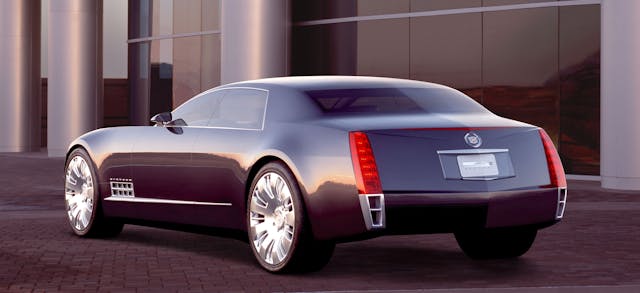
In addition to batting 1000 in output, GM’s XV16 could run on regular fuel and featured “displacement on demand,” which allowed it to cruise on as few as four cylinders. Given full boot, it was allegedly capable of smoking the rear tires of a GMC Yukon durability test vehicle … in three gears.
Unfortunately, GM’s fortunes turned downward shortly after the Sixteen’s arrival. Imports thrived at the domestic brands’ expense. What GM needed more than a Rolls or Bentley beater was a better Chevy Cavalier to fight entry-level Japanese cars. In mid-2009, GM filed for bankruptcy, acknowledging debts twice its assets. By then the remarkable XV16 was but a fond memory.
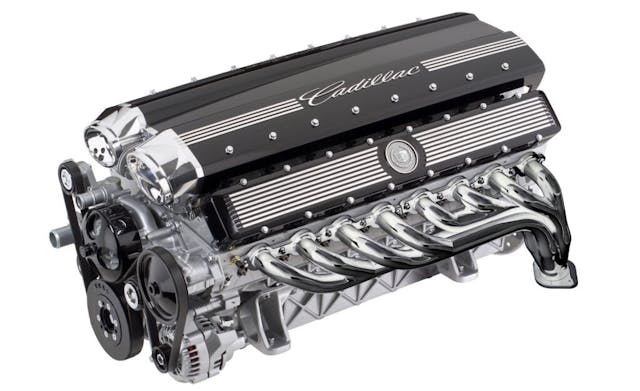
Another Unhappy Ending
At two 2017 Dubai International motor shows, a budding enterprise called Devel unveiled a sports car prototype called the Devel SIXTEEN with over-the-moon aspirations. Its powerplant was said to be a 12.3-liter V-16 equipped with four turbochargers, boosting output over 5000 horsepower while producing 3757 lb-ft of torque.
The feeling, according to Devel, was that of a road-going jet fighter with a 300-mph top speed. While the flagship car was not intended for road use and no price was attached to it, two additional versions were also planned for production: a $1.6-million 2000-hp V-8 edition and a $1.8-million quad-turbo V-16 delivering 4000 horsepower.

According to Devel boss Rashid Al-Attari, the SIXTEEN’s molded carbon-fiber body would be provided by the Italian coachbuilder Manifattura Automobili, and Scuderia Cameron Glickenhaus in New York would construct the space frame chassis. He also credited Steve Morris Engines, a firm located in Muskegon, Michigan, as the engine supplier.
SME has been in business since 2010. Boss Morris filled us in with a few details: “We built and tested a prototype engine which shared the 4.40-inch bore center dimension and basic configuration of GM’s Gen III LS small-block V-8. With a mild camshaft and 20 psi of boost, it produced 3006 horsepower. With 30 psi of boost, it topped 4000 horsepower. Upped to 36 psi, it made 4515 hp, which was all our dynamometer could handle. More than 5000 horsepower was definitely possible here.”
There is video footage of Devels running 100-or-so-mph on test tracks but those prototypes were fitted with Corvette V-8s, not the anticipated V-16. Notes Morris, “Our experimental engine has never been fitted to a car. Unfortunately, Devel seems to have fallen off the face of the earth. From our engine-development perspective, the project ended the same year it began—2017.”
While Devel’s V-16 stretch appears to be unrealistically ambitious, let us ponder two alternatives. The Corvette ZR1 due later this year will build on the Z06’s LT6 5.5-liter DOHC 32-valve V-8 by adding two turbochargers and intercoolers. That new LT7 small-block will bring an estimated 850 hp to the party.
And to all the wildly creative engineers in the audience, we suggest you aim your most advanced CAD/CAM weapons at what we’ll code name LT12 and LT16: engines rising out of the inherent greatness of the Corvette’s LT7 V-8. An 8.2-liter V-12 should produce 1300 hp, while the quad-turbo 10.9-liter V-16 should make 1700 hp … without straining. All the horsepower addicts pondering Devel worship will surely prefer these heavenly alternatives.
***
Check out the Hagerty Media homepage so you don’t miss a single story, or better yet, bookmark it. To get our best stories delivered right to your inbox, subscribe to our newsletters.


















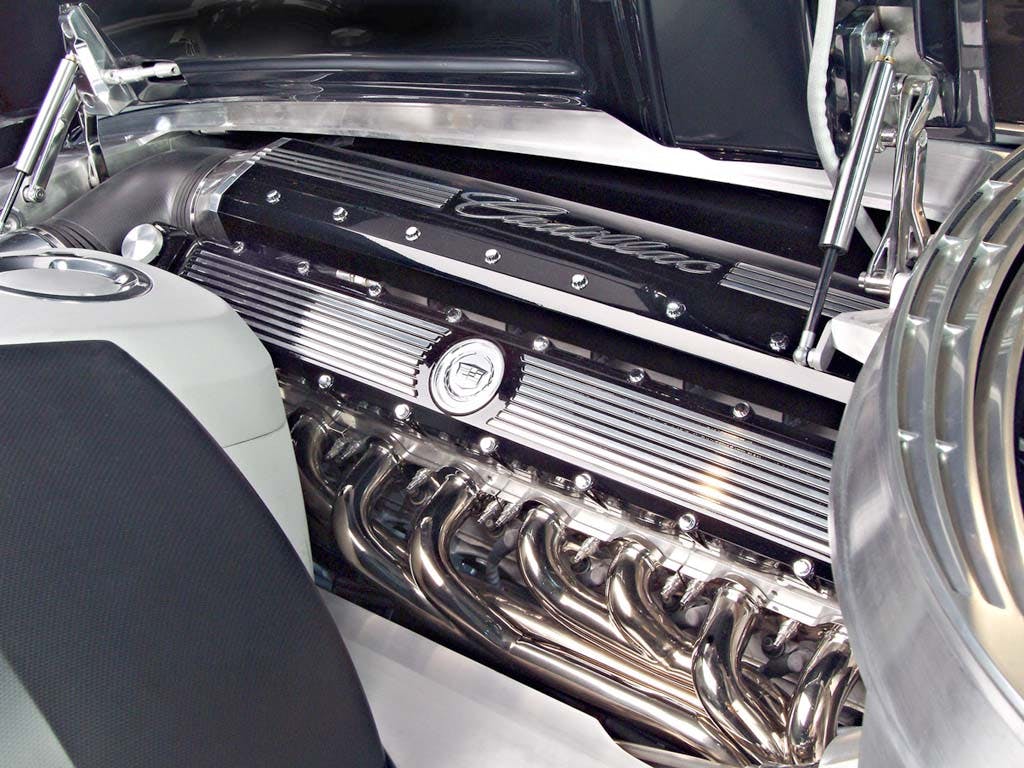



I have nothing against horsepower – for racing. Other than bragging rights or narcissism, what reason does anybody need that kind of power for daily driving on the street? Given speed limits, you can’t get there any sooner than you can with a 150HP car. Mainly though, I see the temptation of street racing. It’s bad enough when children can easily buy cars with well over 400HP these days, so I can imagine the problems created if an immature child with the money can buy upwards to 1000HP, maybe more, off the showroom floor. And I’m not talking about a gear head who builds horsepower into their car, they normally respect that car and it’s capabilities so normally aren’t reckless with it. Should government limit horsepower? I’m not saying that nor would I endorse it. I’m just repeating a warning taken from the Book of Numbers, “Be careful what you ask for, you might get it.”
I’ve been into cars for 60 years but what I really wish they would focus on is milage, not horsepower. That’s the only logical way to head off EVs, at least for a while. 400-500 HP in a street car or truck just kills people, and puts a target on ICE vehicles.
Actually, Neil, many of these 400-500HP cars get pretty good mileage if they’re driven with some degree of sanity. Too many of those who own these cars don’t have the maturity to drive with sanity. But I agree with you, mileage and emissions are the key and I believe the average 200-300HP car of today does a pretty good job at both with better performing engines getting more HP/cubic inch than when we were young thrown in. Yes, we could get power back then but it sure didn’t idle very well. But they sure sounded cool.
In my experience, the SBC IS the MPG king in V8s.
While Larry Webster does a good job above, you get the feeling the above exercises in wow are more for techies and Walter Mitties than real world gearheads. Nonsense like the Devel, et al inevitable, and you can only get so much of that power to the road.
Cadillac brought out their V-16 for 1930 only because their custom-bodied cars often weighed three tons, and a bigger V-8 would’ve brought balance, torque and thermodynamic woes, unable to use the existing transmission.
To Packard’s chagrin, after years of crowing about their V-8, Clark Street brings out a straight eight with the firing impulses halved for less crankpin loading.
Cad had a less complex, more agricultural looking, nearly pancake flathead V-16 from 1938-40, 511 sold.
For many of us preferring charm with performance, inline 8s in old road cars, straight 6s in sport cars plenty enough.
For those in the modern era, hard to beat Chrysler V-8s, tho’ their first was a direct copy of Cad’s ’49 ohv V-8 but with heavy hemi heads. An old mechanic and a friend of his both attributed their hernias to removing Chrysler hemi heads.
Pardon– meant Don Sherman always does a good job, as he did on the above automotive equivalent of professional wrestling. Don, Larry Webster, and Aaron Robinson always tender interesting, well done articles.
High school shop class (automotive, electrical, carpentry etc) was the foundation of many children’s education and activities before it was replaced with “cross dressing 101”
“Woke” didn’t kill off the shop classes — lack of enrollment — and especially, insurance costs — are what killed them off.
Good points, Icy. But not what many want to accept, countering their view of “the good ole days” that never were.
My family bloodline goes back to the beginning of the automobile industry and the world land speed record at the Speed record”!!! Fred Marriott 1906!! 126mph which stood for a hundred years!!
The GM pushrod smallblock is just as extraordinary as the Porsche 911, and both are the products of suboptimal configurations that approach perfection after decades of obsessive refinement. If the SBC were as rare and expensive as the 911 it would be regarded as highly. Instead, it is taken for granted, since any hayseed can stuff a truck motor in a Miata.
Love the Cadillac 16, but leave it to GM to take a baby’s-bottom smooth 16 and make it a Chevette 4 at idle.
The Cadillac Sixteen and her engine…a thing of beauty, a joy to behold.
I need a box of tissues…
Back in 2003, just after dusk I was leaving my job at the GM Technical Center in Warren Michigan. I got on 75 headed toward Rochester Hills. At some point I was passed by what I later became aware of as the “Cadillac 16”, but at the time it was “WTF”…it was so long, Black, and damned if it wasn’t Bob Lutz behind the wheel. Such were the moments to be had working for GM in southeast Michigan before the “crash”. Great times!
Since a 60 degree V works better for a V-12, why not base one on the 60 degree V-6? One could roll their own by simply making a connector for the crankshafts and bolting tow together. Not very elegant, but would work. If a new block and crank were cast like those mentioned based on the SBC it would be much smaller, 5L-7L, but most V-12s aren’t that big capacity wise (Lamborghini was 3.5L-6.5L).
An AMC guy bolted two AMC V-8s (I want to say 360s because they are most common, but may have been401s) together to make a quasi V-16. One trans on rear engine (beefed up). He wanted the torque for a motorhome that he also towed a race car with. At least he had plenty room — just one long “doghouse” in the motorhome! He got it working great, and just about doubled torque. Had towing cams, so it wasn’t revved way up. This is the link: https://theamcforum.com/forum/twin-360s_topic82815_page1.html?KW=V%2D16
His last post in 2012: “So far we put 620 miles on it. Got between 5 and 7 miles per gallon. The best I ever got with one motor was 7.
I was having a little issue. I kept loosing a motor. I’d pull over, shut it off, restart and it came back. Before the last run I put a tac on each motor so I could troubleshoot it. I figured it out at the end, the terminal block I used was a cheap one and corroded right away so I was loosing the rear motor.
Now she’s all put away for the winter.
My real test was Thompson hill. Everyone I know that pulls their racecar with a camper avoids it.
I went up it at 50, I didn’t want to push it too hard as both motors use the same cooling.
Temp was great, I had power to spare, I think I could have gone 80 easily.
I ended up slowing to 20 as I ended up behind a semi in the truck lane but once I got an opening to pull out I was back up to 50 within seconds.”
For a change I got to know the future of cars to come, we have either had or seen the past in some ways, this was refreshing to read.
Just some background on the GM Truck and Coach Div. 60 degree V-12 referenced in your article. GM T&C (now GM Truck and Bus) had a family of 60 degree V-6s, 351, 401, and 478 cu-in, A new block was cast to create the 702 cu-in V-12.It used the 351pistons and rods, two sets of 351 cylinder heads and two 351 intake manifolds/carburetors. It was later supplanted by a 637 cu-in 60 degree V-8 having more power and torque as well as better fuel economy than the 702. Some of these engines were also offered as 4-stroke Diesels (In contrast with the 2-stroke Diesels of the General Motors Detroit Diesel Div.)